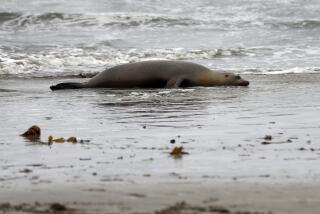These Seahorses Going to Town
- Share via
They had survived a 19-hour flight from Vietnam in a bag of oxygenated water, stashed in a cooler, before they landed at Los Angeles International Airport.
The seahorses -- five males and three females -- were each about 5 inches long. And hungry. Authorities confiscated the animals -- considered a threatened species that can be traded only under special regulations -- and turned them over to SEA Lab in Redondo Beach.
“They came in in fairly bad condition,” said Brent Scheiwe, the facility coordinator who oversees the care of numerous rescued fish and invertebrates in SEA Lab’s building by the ocean. “They were really skinny.” Seahorses have no stomachs, so they have to graze often.
“We didn’t think they were going to live,” said Stefanie Miller, public programs coordinator at SEA Lab. “They had a long ride in a small bag.”
That was about two months ago. After a few weeks basking in a tropical 80-degree saltwater tank, munching on a steady diet of mysid shrimp and krill, the seahorses not only thrived, they got busy.
Three seahorses became pregnant in short order. And as always with the species, the male carried the female’s eggs in his pouch for a gestation period of two to three weeks before going through contractions and expelling them.
“We noticed a couple of weeks ago, their pouches were getting a little bigger,” Miller said, and turning “a brown color. All of a sudden we came in one day and the pouches were huge, really big. We said, ‘Uh oh, we’re going to have some babies.’ ”
Labor can last as long as 72 hours, according to Miller. But one pregnant male was quick. On Saturday, Scheiwe checked the tank at 8:30 a.m. An hour later, the male had spewed forth more than 100 young.
The mortality rate is high for seahorse offspring. At the moment, only about 25 of the ant-size babies are still alive. They have been siphoned off into their own little tank.
“They’re kept separate so their parents don’t eat them,” Scheiwe said. Seahorses are fond of live fish and apparently don’t discriminate.
On Wednesday, the eight adults were gliding in their 45-gallon tank filled with dead coral as well as sun-orange live coral -- also confiscated at LAX. Around them were various tanks filled with ghostly moon jellies, sea bass and a swell shark egg.
The creatures, mostly pale yellow and studded with ridges along their narrow bodies, float along, furling their luxuriously long tails into curlicues, then languidly unfurling them. As they cross paths with one another, they lock tails or drape a tail around another seahorse’s neck. Frequently, one seahorse would wrap its tail around the tank filter and hover.
“They like to hitch onto things a lot,” Scheiwe said.
In a small tank set up inside the bigger one, the newborns -- barely half an inch long -- look like black pieces of thread ingeniously sculpted into the shapes of micro-mini seahorses.
The seahorses kick off their breeding season -- which in the wild lasts roughly as long as their waters stay warm -- with the males vying for the attention of a female that will be their one mate for the whole season, according to Miller.
The males display their pouches to the females. “They show off,” she said. “It’s like, ‘Hey, my pouch is good and strong, look at me!’ ”
Once a female selects a male, the two carry on a daily ritual of courtship, dancing around each other and locking tails, all of which has been evident in the SEA Lab tank, Scheiwe said. The translucent white membrane of a pregnant male’s pouch swells and darkens, from the color of the babies inside, as it grows.
It takes a practiced eye to detect which seahorse is male and which is female, which is pregnant and which is not. All seahorses have a curved hump in front -- it’s below the hump that a little bubble of a white sack shows and starts to swell on a pregnant male.
Scheiwe and Miller point to the male who looks as if he could pop next weekend. They are asked if they can tell which male gave birth last weekend.
“Oh, good luck,” Miller said, chuckling.
“It’s hard to tell,” said Scheiwe, peering into the tank. He points to one swimming by. “It may be the one in front with the deflated pouch.”
It turns out that once the males give birth, they rebound as if it never happened.
“You would think after going through such a long labor, he wouldn’t want to do that again,” Miller said, “but within hours he might be pushing his pouch out again -- ‘Come on, I’m ready.’ ”
SEA Lab, a nonprofit conservation and education center that is open to the public and runs several programs, is more accustomed to rescuing fish that accidentally got caught in power plant saltwater intakes -- such as the horn sharks and lobsters now in the big waist-high tanks outside. Raising seahorses, as Miller puts it, is “a neat little adventure.”
There are seahorses off the coast here, but it’s rare to see one. In addition to being sold live for aquariums, the creatures are often killed and crushed up for Chinese medicines or dried out and sold as souvenirs and ornaments.
“When you see those dried seahorses and sea stars, chances are those were once alive,” Miller said. “We encourage people not to purchase those things.”
She added: “These guys went through such an ordeal. To come through that and have them breed, they must be happy.”
More to Read
Sign up for Essential California
The most important California stories and recommendations in your inbox every morning.
You may occasionally receive promotional content from the Los Angeles Times.











